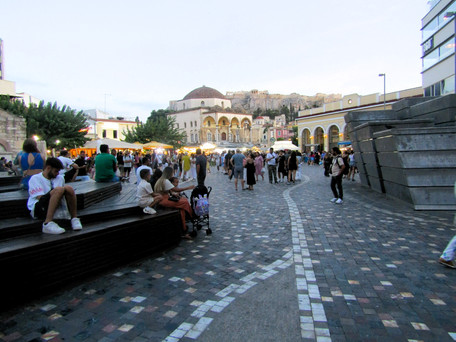Athens Bike Tour is advertised as one of Trip Advisor's 25 highest rated outdoor tours in the world, and I can believe it. The bikes are in great condition, you can choose an e-bike if you prefer, the guide was informative and funny, and Athens with its little alleys and narrow streets is fun to cycle through ... as long as you're in a group! Must be a nightmare for single cyclists.
Our only disappointment was that there was no traffic cop accompaniment as we had in Punte del Este in January. https://www.julie-anne.online/post/punta-del-este (Joke.)
We were all given e-bikes on arrival. Any protests we had were stifled by our realisation that Athens is full of hills, so we were all happy to accept. (Except for one young Texan, who insisted on an unpowered bike 'for exercise'. He then proceeded to tell us wittily every 10 minutes that his e-power wasn't working. Ha ha. Not.)
So up the hill we go to the Observatory, from where we have a great view of — yes! you guessed it! — the Parthenon. Our guide, the cheery Marius (who spoke with a strong Greek American accent after living in the US for years), admitted he didn't even know that Athens had an observatory until his children went on a school visit. Now he brings his bike tours to this spot because it has a great view of the Acropolis.
Zooming (ha!) back down the hill, we pass the distinctive church with the red domed tiled roof — the Church Agio Marina, on the Hill of the Nymphs. We're in the area of Thissio, which has nice open-air restaurants and bars overlooking the city. The young man in our group without a bike helmet is from Canberra. We chided him gently about his choice (you only have one brain etc.) but he told us that since he had no choice in Canberra about wearing a helmet, he was choosing not to wear one here. He was very nice, but a bit silly.
Peeping out between the trees is yet another temple, the Temple of Hephaestus. It's one of the few temples that is intact today. According to Marius, legend has it that since it was dedicated to Hephaestus, it has withstood centuries of earthquakes and other onslaughts. Hephaestus (the Romans called him Vulcan) was the god of blacksmiths, craftsmen, fire, metalworking and volcanoes. Just the sort of dude who would have a solid temple, right?
We reach the Roman Agora. It was built around 10 BC, during the Roman period in Greece. Greek history is really a succession of wars and occupation by other rulers. The ancient Greek civilisation heyday was around 500 BC; by 100 BC, the Romans had conquered various regions of Greece. Over the next few centuries, parts of Greece were invaded and conquered by the Serbs, the Slavs, the Bulgarians and finally the Ottomans/Turks in the 1400s.
But let's stick with the Romans for now and the Agora — the public space — that they built. It reminds me of the Roman Forum. In Rome, I mean. The octagonal tower (third photo) is the Tower of the Winds, which was a clock-tower (sundial!) and a weather station of sorts: each of the eight sides is carved with symbols for the different winds. Although this scientific marvel was constructed during the Roman period, it was a Greek astronomer who designed it. Of course it was.
Jumping to the modern day, 95% of Greeks are Greek Orthodox. The Orthodox churches are magnificently opulent, full of gold and silver and rich colours. I love their theatricality. This is the Metropolitan Cathedral of Athens, the main Greek Orthodox church in the city. It's a relative toddler in terms of age: it was built in the 1840s, and has been repaired fairly regularly ever since after earthquakes. Athens is prone to earthquakes. So far today (it's midday), 19 earthquakes have been registered across Greece. Okay, the biggest one was only magnitude 3.0, but the point is their frequency. In 2023 to date, there have been 46 signficant earthquakes (between 3.6 and 4.8).
This solid little church, located next to the Cathedral, is the Church of St Eleutherios, built in the Byzantine period around 1200 AD so it's about 1000 years old. It's still here and lookin' strong.
Wandering (or cycling) through the city in the right places is charming. The wrong places are less charming, but I didn't take photos of those areas. It's a big city, after all, home to 5 million people. Some places are downright dodgy. Stick to the tourist paths and have fun! (Good advice for all tourists, wherever we are.)
The Panathenaic stadium is the only stadium in the world that is built entirely of marble. The site was first used as a stadium in 300 BC, but this one was built for the first modern Olympic Games in 1896. It was used for the Olympics in 2004 when Athens hosted the Games, and is used every year for the finish of the Athens Classic Marathon. (Don't forget the origin of the 'marathon'. The soldier who ran 42 km from the battlefield in Marathon to deliver news of the victory in Athens died of exhaustion on delivering his news. Not a good omen for future marathon runners.)
The stadium seats about 50,000 people but Marius said he'd been to a basketball game where there were 65,000 spectators. They were seated cosily, apparently. For all its lovely classical lines, Marius's first-hand experience is that marble seats are very uncomfortable and the reflected sunlight is blinding.
The Zappeion (bankrolled by the Zappa brothers — no relation to the more famous Frank) is now a convention centre, but it was built for the first modern Olympic Games in 1896. It was the site for fencing. The Neoclassical style strikes me as a bit austere (where are the statues of the gods?), but there was a modern Narcissus in front of me. The woman taking selfies was completely oblivious to anything but herself.

One more historical site before we hand back our bikes. The Temple of Olympian Zeus was begun by the Greeks in 500 BC and was intended to be the biggest temple in the ancient world, but it was only completed during the Roman era by the emperor Hadrian. It fell into ruins after a barbarian raid and all that remain today are a few very, very large columns. One is lying down — you can see clearly how these enormous columns were constructed in pieces. Hadrian also constructed Hadrian’s Gate, next to the temple. This marks the line where the ancient Greek city gave way to Roman development.
After all this touristing, we enjoyed another form of touristing: just sitting with a cold drink and a souvlaki. Monastiraki may be one of the most touristy areas but hey, who cares. It's fun and buzzy and if you avoid the pickpockets, safe enough.
I enjoyed the little gypsy girl playing her drums (she was about 10!), and yes, I gave her some money. We saw her and her two small brothers (I assume) the next night counting some coins in the square.
The other equally touristy and equally enjoyable area is Plaka.
It's a nice city, in the right parts of it. We approve.
More to come.


























































































well done Julie-Anne. lots of information for all. I particularly liked the photo of the Temple of Hephaestus - natural setting gives some sense of ancient times. Ken made a rare appearance - looking well Ken. Best wishes, Ron
Lovely to see the Plaka area again … the cycle tour is a great way to get around the city as the traffic is so bad. Lovely photos of the different areas and ancient buildings .